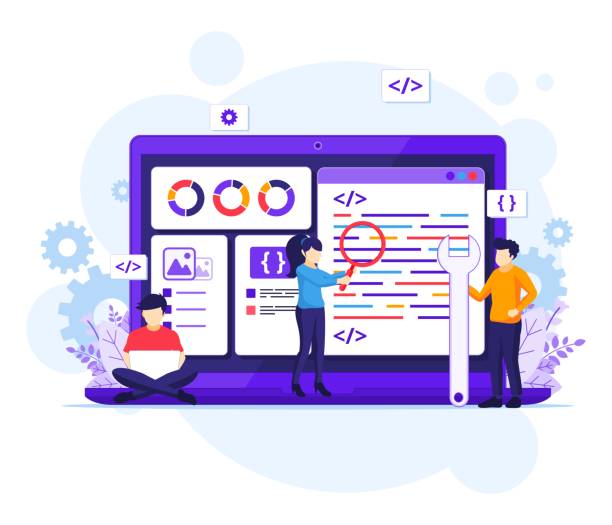Introduction to Secure Website Design and Its Importance

In today’s digital world, where our reliance on the internet is growing day by day, #SecureWebsiteDesign is no longer an option but an undeniable necessity.
Websites act as business storefronts, communication platforms, and centers for storing vital information.
Therefore, protecting them against cyberattacks becomes doubly important.
Imagine an e-commerce website where customer credit card information is stored, being infiltrated; the result would be nothing but loss of user trust, financial damage, and brand reputation destruction.
Website security not only includes protecting sensitive data but also ensures that the website is always accessible and free from disruption.
The main goal of secure website design is to create a reliable online environment resistant to various cyber threats.
This requires a deep understanding of potential vulnerabilities and the implementation of appropriate defensive mechanisms at every stage of the website’s life cycle.
From initial programming and server selection to continuous maintenance and updates, everything must be done with a security-focused approach.
This comprehensive approach is the only way to ensure that your website not only functions properly but is also protected against infiltration and data theft.
Below, we will discuss various aspects of secure website design in detail.
Are you concerned about your e-commerce site’s low conversion rate and not achieving your desired sales?
Rasawweb is your specialized solution for a successful e-commerce website.
✅ Significant increase in conversion rates and sales
✅ Professional and user-friendly design to ensure customer satisfaction
⚡ Ready for a transformation in online sales? Get a free consultation!
Understanding Common Web Threats and Penetration Methods

To engage in secure website design, we must first become familiar with its enemies.
Websites are constantly exposed to various types of cyberattacks, each attempting to infiltrate or disrupt their functionality in a specific way.
One of the most common and dangerous of these attacks is SQL injection, through which attackers can inject malicious SQL commands into the website’s database to extract or manipulate sensitive information.
This attack demonstrates how improper input validation can lead to disaster.
Another frequently observed attack is Cross-Site Scripting (XSS), where the attacker injects malicious JavaScript code into website pages.
These codes then execute in the victim’s browser and can lead to the theft of cookies, user session information, and even page content alteration.
Distributed Denial of Service (DDoS) attacks also aim to take a website offline by sending a massive volume of fake traffic to the server, preventing legitimate users from accessing it.
Securing the site against these threats requires a deep understanding of their mechanisms and the implementation of appropriate defensive solutions.
In addition to these, we must also mention Broken Authentication, Insecure Deserialization, and Security Misconfiguration attacks, all of which can be serious weaknesses for a website.
The Role of Security Protocols in Secure Website Design (SSL/TLS)

One of the most fundamental and crucial steps in secure website design is the implementation of SSL/TLS (Secure Sockets Layer / Transport Layer Security) protocols.
These protocols are responsible for encrypting communications between the user’s browser and the website server.
Simply put, when you enter information such as your username, password, or bank card details on a website, SSL/TLS ensures that this information is transmitted in an encrypted form and remains out of reach of unauthorized individuals.
Not using these protocols means that your information is transmitted as plain text over the internet, and anyone who can eavesdrop on network traffic can easily read it.
The SSL certificate, which is essentially a digital file, is issued by a Certificate Authority (CA) and verifies the website’s identity.
The presence of this certificate in the browser is indicated by a lock icon and the “https://” prefix in the address bar, which is a clear sign of website security for users.
Google has also long prioritized websites with SSL in its search results ranking, so its use is important not only for security but also for Search Engine Optimization (SEO).
The table below shows the advantages and disadvantages of SSL/TLS:
| Advantages | Potential Disadvantages |
|---|---|
| Encrypting data and protecting user privacy. | Requires purchasing and renewing certificates (some are free). |
| Increasing user trust in the website. | May slightly affect page load speed (negligible). |
| Improving SEO ranking and visibility in Google results. | Initial configuration may require technical knowledge. |
| Protection against Man-in-the-Middle attacks. | Complexity in troubleshooting certificate-related issues. |
| Compliance with security and legal standards (such as GDPR). | The protocol alone does not prevent all web attacks. |
Using SSL/TLS is the cornerstone of any modern secure website design and is the first step in building a trustworthy website.
Secure Coding and Best Practices for Developers

Secure website design goes beyond installing an SSL certificate or configuring a firewall; a large part of it comes down to the quality and security of the written code.
Developers play a pivotal role in ensuring website security, as vulnerabilities often arise from programming errors.
The first and most important principle in secure coding is Input Validation.
Any data entered into the system by the user, whether through forms, URLs, or cookies, must be carefully examined to ensure it has the correct format and does not contain any malicious code.
This prevents attacks such as SQL Injection and XSS.
Another principle is using Prepared Statements for database interaction.
This method ensures that user inputs are processed as data, not as part of SQL commands, thereby completely eliminating the risk of SQL injection attacks.
Also, Output Encoding is vital to prevent XSS attacks.
This process ensures that any data retrieved from the database and intended for display on the web page is encoded in such a way that malicious code is interpreted as plain text, not as executable code.
In addition, proper error handling is very important.
Displaying technical information or detailed error messages to users can help attackers identify system weaknesses.
Therefore, error messages should be general and vague.
Secure Session Management, strong encryption for storing passwords (such as using one-way hashing functions with salt), and adherence to the Principle of Least Privilege in coding are also critical.
By following these principles, developers can lay a solid foundation for a secure website.
Does your company’s website perform as well as your brand deserves? In today’s competitive world, your website is your most important online tool. Rasawweb, a specialist in professional corporate website design, helps you to:
✅ Gain brand credibility and customer trust
✅ Convert website visitors into customers
⚡ Get a free consultation now!
Database Security and Protection of Sensitive Information

The beating heart of many websites and applications is their databases.
This is where vital user information, orders, products, and other sensitive data are stored.
Therefore, database security is an essential pillar in secure website design.
Any security breach in this section can lead to the disclosure of personal information, financial misuse, or even complete business destruction.
The first step in securing the database is to restrict access to it.
Only authorized IP addresses and authenticated users with the least necessary privileges should be able to connect to the database.
This means avoiding default usernames and passwords and setting complex and unique passwords.
Encrypting sensitive information in the database, especially financial and personal data, is of paramount importance.
Even if an attacker successfully infiltrates the database, the encrypted data will be useless to them.
Using strong hashing functions (such as bcrypt or scrypt) to store user passwords instead of storing them directly is a basic principle.
These functions are irreversible, and even if the database is leaked, the original passwords will not be recoverable.
Furthermore, regular updating of the Database Management System (DBMS) such as MySQL, PostgreSQL, or MongoDB to the latest stable and patched versions is highly important.
These updates often include security patches for discovered vulnerabilities.
Also, performing regular and tested backups of the database creates an additional layer of defense against data loss due to cyberattacks or system errors.
Proper configuration and continuous monitoring of database logs to identify suspicious activities are also key methods for protecting sensitive information.
The Role of Firewalls and WAF in Website Protection

Alongside secure coding principles and proper configuration, firewalls and specifically Web Application Firewalls (WAF) play a vital role in complementing the secure website design strategy.
Traditional firewalls operate at the network level, filtering incoming and outgoing traffic based on predefined rules.
They can block unwanted ports or deny access from specific IP addresses.
These types of firewalls provide a strong first line of defense, but they are not sufficient for protecting against more complex attacks that target the seventh layer (application layer) of the OSI model.
This is where WAF (Web Application Firewall) comes in.
WAF is specifically designed to protect web applications against application layer attacks.
Unlike network firewalls, WAF can inspect HTTP/HTTPS traffic with greater precision and identify and block malicious traffic patterns related to attacks such as SQL Injection, XSS, and Cross-Site Request Forgery (CSRF).
A WAF can be installed as software on the website server, as an independent hardware appliance, or offered as a cloud service.
The great advantage of WAF is that it can protect against vulnerabilities that have not yet been discovered or fixed in the website’s code.
This is particularly valuable when rapid code updates are not feasible.
Some WAFs use artificial intelligence and machine learning to identify new attack patterns and continuously improve their ability to defend the website.
Implementing WAF as part of a comprehensive website security strategy adds an important layer of defense and significantly increases the website’s resilience against cyberattacks.
Continuous Website Updates and Maintenance for Sustainable Security

Secure website design is not a one-time process, but an ongoing commitment.
Even if your website was initially built with the best security practices, new vulnerabilities will quickly emerge without continuous maintenance and updates.
Cyber attackers are constantly looking for new ways to infiltrate, and new vulnerabilities in operating systems, web servers, frameworks, Content Management Systems (CMS), and plugins are regularly discovered.
Regularly updating all website components, including the core CMS (such as WordPress, Joomla, Drupal), all plugins and themes, as well as the web server (Apache, Nginx), programming language (PHP, Python, Node.js), and database (MySQL, PostgreSQL), is critically important.
These updates often include security patches that address identified weaknesses.
Neglecting these updates turns your website into an easy target for attackers.
In addition to updates, regular security scans and Penetration Testing help identify vulnerabilities before attackers discover them.
These processes periodically simulate and examine website weaknesses.
Also, monitoring logs and server/application reports to detect suspicious activities is an integral part of security maintenance.
Proper configuration of automated backups and having a Disaster Recovery Plan also ensures that even in the event of a successful attack, you can quickly restore your website to normal operation.
A secure and stable website requires continuous attention and effort.
| Item | Description | Importance |
|---|---|---|
| CMS and Plugin Updates | Install the latest security patches for the Content Management System and all its components. | High |
| SSL/TLS Configuration | Ensure HTTPS usage and certificate validity. | High |
| Input Validation | Review code to prevent SQL Injection and XSS. | High |
| Database Security | Encrypt sensitive information, limit access, regular backups. | High |
| WAF Usage | Implement a Web Application Firewall to protect against application layer attacks. | Medium |
| Password Management | Enforce strong passwords and regular change policies. | High |
| Backup and Recovery | Implement a regular and tested backup plan for quick recovery. | High |
| Monitoring and Logging | Enable security logs and review them regularly. | Medium |
Countering DDoS Attacks and Defensive Methods

Distributed Denial of Service (DDoS) attacks are among the most disruptive threats that can nullify your efforts in secure website design.
The main goal of these attacks is to take the website offline by sending a massive volume of fake traffic from multiple sources to the server, so that the server cannot respond to legitimate user requests.
Countering these attacks is complex, as distinguishing between legitimate and malicious traffic is difficult.
One of the most effective methods for countering DDoS is using web hosting services with DDoS protection capabilities.
Many cloud service providers and CDNs (Content Delivery Networks) like Cloudflare or Akamai, have built-in solutions for identifying and filtering DDoS traffic.
These services route traffic through their extensive networks, identify and block suspicious traffic patterns, and deliver only legitimate traffic to your origin server.
In addition, increasing bandwidth and server resources can somewhat help absorb additional traffic during an attack, but this is not a complete solution as attackers can provide infinite resources.
Implementing strong firewall rules and Intrusion Detection Systems (IDS) and Intrusion Prevention Systems (IPS) can also help detect and block some types of DDoS attacks.
These systems can limit the request rate from a specific IP or identify unusual traffic patterns indicative of an attack.
Secure website design for DDoS resilience requires a combination of infrastructural, software-based solutions, and collaboration with specialized security service providers to ensure your website remains accessible even during peak attacks.
Are you tired of your company’s website not getting the visibility it deserves and losing potential customers? Solve this problem forever with professional and effective website design by Rasawweb!
✅ Increase brand credibility and gain customer trust
✅ Attract targeted sales leads
⚡ Contact us now for a free consultation!
Backup and Disaster Recovery Planning

Even with the best secure website design approaches, the likelihood of unfortunate incidents, including successful cyberattacks, human errors, or hardware failures, never reaches zero.
In such circumstances, having a strong backup strategy and a Disaster Recovery Plan (DRP) will be your business’s last line of defense and savior.
Regular backups ensure that even if primary data is lost, you have a healthy and recoverable copy of the website and database.
It is recommended that backups are not only performed regularly and automatically but also stored in multiple separate storage locations, including cloud storage and off-site physical storage devices.
This approach helps prevent the loss of all backups in the event of a disaster in one location.
Also, regular testing of backup restorability is of high importance.
Many businesses do not realize that their backups are corrupted or unrecoverable until they face a real incident.
A Disaster Recovery Plan (DRP) is a comprehensive document that specifies the exact steps for recovering systems and data after a disaster.
This plan should include details of the Recovery Time Objective (RTO) and Recovery Point Objective (RPO).
RTO represents the maximum time the website can remain offline, while RPO is the maximum amount of data that can be lost.
The DRP should include communication protocols, team responsibilities, and step-by-step checklists for service recovery.
Securing the site without an effective backup and disaster recovery plan is like building a house without insurance; the risk is unacceptable and can lead to business destruction.
The Future of Secure Website Design and Upcoming Challenges

The world of secure website design is constantly evolving, and new challenges are always appearing on the horizon.
With technological advancements, cyber threats are also becoming more complex and intelligent, requiring innovative and proactive approaches in cybersecurity.
One of the biggest challenges ahead is the emergence and proliferation of AI-powered attacks.
Attackers can use AI to identify vulnerabilities, generate automated malware, and even conduct highly convincing phishing attacks.
In response to these threats, the use of AI in cybersecurity defense is also increasing.
AI-based security systems can identify unusual traffic patterns with greater accuracy, predict attacks, and automatically respond to them.
This will turn into a battle between attacking and defending AIs.
Additionally, Internet of Things (IoT) security and connected devices have become a growing concern, as many of these devices can become new entry points for network and website infiltration.
Web3 development and blockchain technology also bring new challenges and opportunities in security.
While blockchain inherently offers more security due to its decentralized nature, decentralized applications (DApps) and smart contracts can also have unique vulnerabilities that require different security approaches.
Ultimately, user education and awareness will always be a key factor.
Even the most advanced security systems cannot withstand human errors or social engineering tricks.
The future of secure website design requires a multifaceted, dynamic, and continuously learning approach to keep pace with evolving threats.
Frequently Asked Questions
| Row | Question | Answer |
|---|---|---|
| 1 | What is secure website design? | Secure website design is the process of building websites with security measures in mind from the initial stages of development to protect against cyberattacks, unauthorized access, and data loss. |
| 2 | Why is secure website design important? | Website security is crucial for maintaining user trust, protecting sensitive information (personal and financial), preventing brand reputation damage, and complying with privacy and security regulations (such as GDPR). Security breaches can lead to financial and legal damages. |
| 3 | What are the most common cyberattacks a website faces? | Some of the most common attacks include SQL Injection, Cross-Site Scripting (XSS), Distributed Denial of Service (DDoS), Brute Force, and Credential Stuffing attacks. |
| 4 | What is SQL Injection and how to prevent it? | SQL Injection is an attack where the attacker attempts to manipulate the database or extract information by injecting malicious SQL code into the site’s inputs. To prevent it, you should use Prepared Statements/Parameterized Queries, ORM (Object-Relational Mapping), and rigorous input validation. |
| 5 | What is Cross-Site Scripting (XSS)? | XSS is an attack where the attacker injects malicious scripts (usually JavaScript) into web pages, which are then executed by other users’ browsers. This can lead to the theft of cookies, session information, or alteration of the website’s appearance. |
| 6 | How can Brute Force attacks on login pages be prevented? | To prevent Brute Force attacks, you should use CAPTCHA, limit the number of failed login attempts (Account Lockout), Two-Factor Authentication (2FA), and enforce complex and long passwords. |
| 7 | What is the role of HTTPS in website security? | HTTPS uses SSL/TLS to encrypt communication between the user’s browser and the website server. This prevents eavesdropping, tampering, or forgery of information during transmission and increases user trust. |
| 8 | What is the importance of Input Validation in security? | Input Validation is the process of checking and sanitizing data entered by the user. This prevents the injection of malicious code, XSS attacks, SQL Injection, and other vulnerabilities, ensuring that data conforms to the expected format. |
| 9 | Why is regular updating of website systems and software necessary? | Regularly updating the operating system, CMS (like WordPress), plugins, themes, and libraries used fixes known security vulnerabilities. Hackers often exploit weaknesses in outdated software to infiltrate. |
| 10 | What role do regular backups play in secure website design? | Regular and tested backups of website information (database and files) are a vital layer of defense against data loss due to cyberattacks, human errors, or hardware failures. This allows for quick website recovery in the event of a disaster. |
And other services of Rasawweb Advertising Agency in the field of advertising
Smart Marketplace: An effective tool to improve SEO ranking by optimizing key pages.
Smart Marketplace: A dedicated service for campaign management growth based on custom programming.
Smart SEO: An effective tool for attracting customers by using real data.
Smart Custom Software: Transform user interaction with precise audience targeting.
Smart Brand Identity: Professional optimization to improve SEO ranking using SEO-driven content strategy.
And over hundreds of other services in the field of internet advertising, advertising consultation, and organizational solutions
Internet Advertising | Advertising Strategy | Advertorials
Sources
Key Tips for Secure Website DesignBest Practices for Data ProtectionProtecting User Privacy on the WebComprehensive Cybersecurity Guide
? Rasawweb Afarin Digital Marketing Agency, specializing in boosting your business by providing comprehensive SEO services, targeted advertising, and professional website design.
📍 Tehran, Mirdamad Street, next to Central Bank, South Kazerun Alley, Ramin Alley No. 6


